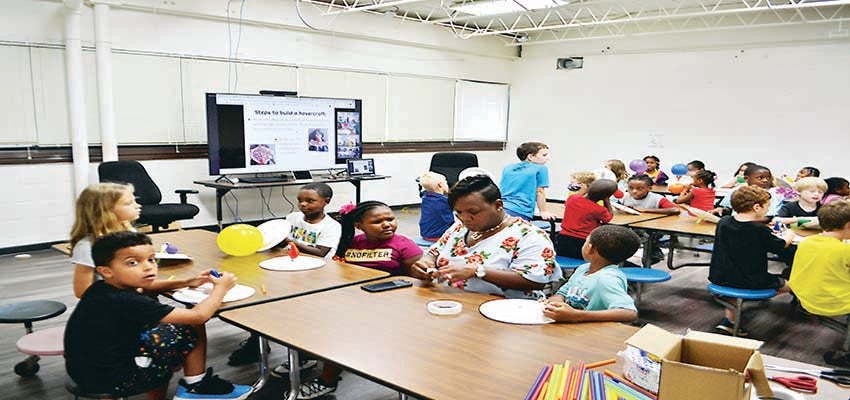Growth Academy provides educational assistance
Published 8:14 am Wednesday, July 21, 2021
|
Getting your Trinity Audio player ready...
|
VALLEY — A truly ambitious project is in its startup phase on Shawmut Circle. It’s called Growth Academy, and it’s taking up where the Boys & Girls Club left off when it was discontinued locally at the end of last year.
Growth Academy has a lot going for it. It’s in a 27,000-square-foot building that looks like a school, over $200,000 has been invested in upgrading the interior, and with the Chambers County Circle of Care Center for Families it has a the full support of a local non-profit with 25 years experience in getting grants. There’s also an important tie-in with local schools.
Jeremy Johnson of LaFayette, the national sales manager for Zoom, is the board chair, and Zoom has a significant presence in the building. Other board members include Chambers County Superintendent of Education Casey Chambley, Lt. Sandra Crim (a school resource officer), West Point educators Ken and Heather Hoats, Michael and Leslie Weiss and Chelsea Myers. Kim Dozier, who formerly directed the local Boys & Girls Club, is the new director of Growth Academy. Katie Herston, a psychometrist with the Chambers County School District, is over Growth Academy’s tutoring.
An average of 56 children in the 6-12 age group are in the building every weekday. That number will grow by approximately 20 students when Sunflower House merges with Growth Academy in the fall. The number could get as high as 120 as interest picks up.
Growth Academy’s location on the Circle is considered a huge asset. The students who are there receiving one-on-one instruction, spend part of their day in recreation activities in nearby Shawmut gym and on the Roger McDonald ball field.
“We have seven certified teachers and five to seven core staff that are part of our after-school program,” said Yancey Gatlin, a Growth Academy booster. “There’s lots of interest on the part of teachers in what we are doing. We have another 19 or 20 more on standby. This is good STEM-level help to local schools. We want to make sure we have a curriculum that’s compatible with local schools. What they are learning here will help them when their classes start.”
Students can be at Growth Academy from 7 a.m. until 6 p.m. on the weekdays. Some of that is at Bob Harding-Shawmut Elementary, some at the gym and some on the ball field. Coach Kyle Cobb works with them in youth sports.
The hours are expanded during the summer. When school starts, they will go back to four hours per day — 2:30 p.m. to 6:30 p.m.
The Alabama Children’s Trust Fund is providing STEM Zoom classes two hours every day. Jonathan Herston and Kathy Richardson of the Circle of Care have been helpful in seeking grants and taking care of the accounting needs.
Just inside the front door is a large lobby area. On the floor is a large painting of a learning tree done by local artists Thea McElvy and Tawana Henson. A lot of work has been done on the building’s floors. There’s over 8,000 square feet of commercial linoleum and a large amount of stained black concrete. The new flooring has replaced old flooring that contained asbestos, and it took some two months to have it carefully removed.
Past the lobby is a large room reserved for a library. Some cedar shelves filled with books are already in. It will no doubt be a fast growing place. Bradshaw-Chambers County Library has already made some donations to help the library area grow.
Auburn University has offered a major helping hand by donating an estimated $20,000 in furniture that had been stored in warehouses. Included are lots of tables and desks.
There’s ample space in the huge building, plenty of space for STEM learning labs, virtual reality and theater rooms and rooms of art and music instruction.
“We welcome talented people to come in and help,” Gatlin said. “We will be helping the students with their homework and in filling in gaps they may have. Katie Herston is helping us with our testing. Students from Point University have been helping us, too. We have one-on-one tutoring, and we are doing our best to get the right tutor for the right kid. Our main focus is to take the pressure off parents and the school system to have children on grade level. We want teachers to have classes that are even keel, that no one has been left behind.”
The plan is for Growth Academy to help the younger students to be at, or above, their grade level and help the older kids be on a path of going to college.
“We want to inspire children on possible career options,” Gatlin said. “We want them to pursue their dreams.”
It’s good when young students learn that someone with a career tech-level education in the right field can make a very good living.
“Kids are cognitive sponges,” Gatlin said, “but you need to get them interested at an early age.”
It’s important for Growth Academy to be as self-sustaining as possible. That’s where grants and a strong groundswell of local community support comes in.
Inside the building are reminders of a time when the WestPoint Stevens Engineering and Environmental Department was housed there. In a back room are some large gauges that were once electronically linked to the local mills. They could tell, for example, which mills were doing good work in getting finished products out the door. Those gauges provided a means of giving employee bonuses for doing good work.
One item kids aren’t allowed to have inside the building is a cell phone. It’s a distraction that can easily take away from the instructions that’s taking place.
“We want kids to understand what’s important in life,” Gatlin said. “A lot of our kids have never traveled much. The content in our Zoom classes lets them know there’s a lot going on in that great big world out there. This is something that can get them dreaming about what they can do.”
There’s a big room in the back that can be modified for indoor sporting activities such as basketball, batting practice or throwing a football.
“We want kids to draw their own conclusions and to have positive optics for life,” Gatlin said. “We want the kids to get the most out of this that they can. We want it to help keep them in school.”





